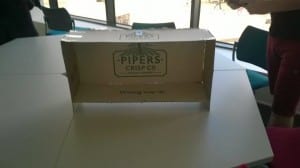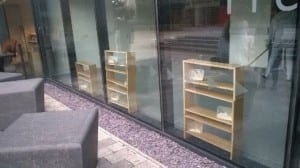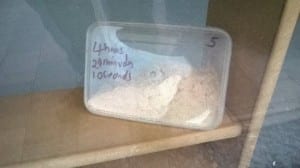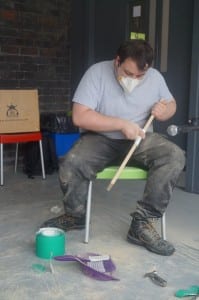Framing Statement
Our final performance (known as shelved) is an exploration of the history of The Great Central warehouse library. The piece is a representation of the manual labour that occurred within the library. In order to create the performance we will take over the free zone in the library for a full 9-5 day and turn it into a workshop environment. Within this workshop we going to build and construct several shelving units. By doing this we can represent several things such as the labour that took place in the library while it served as a grain warehouse, the labour that went into converting the warehouse into a library while producing one of the most common objects in a library, shelves. Once we had converted this into a workshop area we added another dimension to the performance. By adding microphones the room and offering the public wireless headphones we are able to allow the general public to roam around the library experiencing the sounds that once occurred in the warehouse, in the space it actually happened. This intermedia performance allows for the audience to contrast the history of the library by examining a noisy soundscape which the Great Central Warehouse once was however as soon as the headphones are taken off it becomes a quiet library once more. This intermedia performance is an exploration of the library’s history. From a library to grain warehouse we were able to incorporate subtle and not so subtle aspects of this broad history. This performance can be linked to performances such as Janet Cardiff’s 40 Part motet, Jean Claude and Christo’s wrapping of the Reichstag and Sarah Jane Norman’s Bone Library.
Analysis of Process
When this project was first started we explored the library several times and found a range of spaces within the library which I personally had not previously come across and was unaware existed. These explorations also allowed me to see a lot of the library’s history as a warehouse, throughout the library are steel beams with engravings which show the industry side of the library. This major difference in environment appealed to us as something that has potential to be explored and discover if it would be possible to bring the industry side back into the library through our performance. We floated around different ideas of doing this one which was considered was to convert the library into a workshop situation and wrap the room to turn it into something it is not. By doing this we reflect on Christo and Jeanne Claude’s performance where they wrapped the Reichstag. By doing this they were able to mask the building and then transform it into something it is not. And making a point that at the end of the day it is just a building. This is something that we could explore by covering the room and transforming it into a workshop. It’s turning the room into something it is not designed to be and by doing this we are adding emphasis to the fact that it is just a room and can be used for purposes it is not necessarily designed for.
The workshop idea also allowed us to experiment with the sounds of the library. Whilst doing an exercise in class I created a soundscape on the silent floor of the library and listened carefully to see how quiet it actually was there. This set up the possibility of doing something related to that floor especially since around that entire floor are signs asking us to be quiet, however that’s all it was just signs. We wanted to know what is forcing people to be quiet in this space why we should have to be and who is actually making us be quiet. The difference then became very clear between the warehouse then and the library now and how the space has been adapted for a new function as the area around it had developed. The idea of creating a workshop back in the library suddenly became much more appealing and potentially doing this on the library’s silent floor to create a conflict of times so to speak and allow the sounds of the past to be made in the silent spaces of the present day library.
The more we started to look the more we could start to see divides in the library, divides of the old and the new. We could identify the new additions in a way we had not previously thought about and we began to notice influences on the more recent architecture. We found the a clear difference between the old architecture and the new however they worked well together and nothing looked out of the ordinary. Finding all this inspired us to explore the architecture of the building, the question was how would we do this? We wanted to combine the workshop element with the architecture and the idea that came up was to build and create a model of the library.
By building a model it allowed us to really explore the architecture because we would literally be spending time to build each part of the library. We soon realised we could take this to another level by building the library in sections. We could begin by building it reminiscent of the original architecture by building the library before the recent additions and expansions of the library. We would then follow up by expanding on the model by adding on the parts of the library that were added first.
Utilising the model seemed to be the perfect idea to explore the architecture and the history of the library together and allowed us to utilise the workshop environment at the same time. Our next step as a group was to create a version of the library. We had found a space we believed to have potential on the 3rd floor of the library as it had a small group working room which would keep us out the way of people but had been surrounded by glass meaning people would be able to watch in on us working. The room also had walls which included both recently added and original architecture which allowed for further visual representation of the coming together of these two eras in the library’s history. We decided to build our initial vision out of cardboard so we could keep the noise levels to a minimum and we would be able to get an idea of how we would be able to make this using lightweight materials before using the heavier wood. The model however did not work as we planned we had misjudged the materials we had used and we had been louder than we initially planned resulting in us being spoken to by the library staff and being asked to keep quiet due to other student complaints. After this we decided it would be best to find a more suitable space, which turned out to be the free zone on the ground floor. This space allowed us to maintain many of the same visual element within a much larger space however it too away from the silence contrast. To overcome this obstacle we decided to try and muffle the sound of all the tools and visually represent loud activities attempting to be silent by following library function. Utilising the free zone worked out to be a better space for the project as it allowed us the space we needed.
We then presented our project idea however it was made apparent with our lack of experience the end product would not live up to the projects potential. We decided against the idea of building a model and then decided to build shelving units instead. Building these still allowed for us to utilise all the messages we were trying to portray apart from the architecture. Instead we shifted our focus from the exterior to the interior architecture and what the main point is. Shelves do more than just keep books, they hold data and knowledge and are a key part to the library. They were also more practical for us to construct and we were able to produce more than one. By producing multiple shelves we were able to show how libraries are still expanding and growing bigger as more resources become available.
Once we had decided on what we were building we began the process of designing our end product and we constructed out of cardboard a very simple and easy to construct shelf.

This design required us to use minimal material which meant we were able to produce more of them in one day. Once we had designed our next step was to build one so we sourced some wood and built our first shelf which was a success within its own right, even though it didn’t look the design we were able to see here we went wrong and then we were able to create another which was more successful after we corrected our mistakes.
We were now at a point where we were comfortable with where we were on the shelf itself and so we were able to begin our work on the sound aspect of the performance. Since the performance itself was no longer on any of the main floors of the library we decided to utilise wireless headphones. By using these we were able to allow the sounds to travel through the library despite us being away from any of what would have been original working spaces. We now had to find ways to dull the sound of the tools down however so visually the audience could see us following the library rules of keeping noise to a minimum level. We began by wrapping the hammer with various materials such as dusters, rubbers and sponges and we tried to see what sounded the most muffled to the ear. After installing audacity we were able to measure the decibels of each item and discover that way which was actually the quietest.
Once we had discovered which made the least noise we had to discover which was the most practical to use. Initially the quietest was mixing all 3 together however when the hammer came in contact with the nails the rubber and the sponge both broke eliminating them meaning the best option was to simple use dusters. This however also became impractical as it was not possible to get the force behind the hammer to do anything to the nail and the shape the duster created when it was wrapped around the hammer meant it was difficult to actually hit the nail with the hammers head. We also discover we were not actually able to dull out any other sounds the paint brush was quiet on its own and the sawing didn’t work muffled. Below is a soundscape which features the all the hammers with their respective muffleing.
Once we had gaged the decibel levels through audacity we added the microphones into the project. Once we had added the microphones it we were able to pick up the noise from each tool individually and the decibel level became significantly more sensitive and each noise became much clearer to hear. Utilising the microphones audacity and wireless headphones allowed us to use maximum potential of sound allowing the audience to hear it and be able to witness the sound. Offering this really allowed the contrast between a library and a workshop to be shown. The way we are utilising the sound is similar to how Janet Cardiff used it within her 40 Part Motet. She created her piece by placing microphones in front of each member of an orchestra and the sound is then transmitted to another room full of speaker systems which relay the sound into a live soundscape of the orchestra. In our performance we are also relaying sound through to wireless headphones creating a live soundscape of workshop conditions while focusing microphones on each worker.
Following on from all this we decided to explore the library’s history further. Since the library used to be a grain warehouse we decided to show this by collecting the sawdust which fall from the shelf as it is being created. Inspiration further came from Sarah Jane Norman’s performance of bone library. In this performance she engraves aboriginal words onto bones. By doing this she is giving the bones purpose and treating them as books, the fundamental element on a library. We could utilise this and by collecting labour residue and placing that on the shelf it is giving the shelf a purpose. By collecting data of time taken to create the shelf and recording it on the boxes of saw dust we are able to house data on these shelves, which is a key function of the library, to house and store data. This is also reminiscent of an activity done within the second week where we created our own artist books out of whatever materials we could to show that you can store information any way you feel and it doesn’t necessarily need to be in the traditional words on pages. A book can show data through a collection of pictures or through by a representation of the message you’re trying to get across. This is exactly what collecting the grain was intending to do.
We also felt like showing the manual labour aspect of the library was necessary to include. The fact that the library have very much shifted to mental work as opposed to physical work is apparent. By converting the library into a workshop allows us to represent the physical work that used to take place. We figured we should work an 8 hour working day and include an hour lunch break through the day in order to mirror the average working day. The process was also repetitive by creating the same object multiple time we are able to represent another aspect of the library, the students. While we are performing it will be exam and deadline period for otherstudents. Due to this busy time period students will be going to the library multiple times to find resources and repeating their action by going to the library, doing work, going home then the same routine again the next day.
Performance Evaluation
By adding all this together we are creating a project that could engage the audience on multiple levels and we utilised many different forms of media to create a multimedia and interactive performance which allowed for the audience to achieve everything we intended. We were able to replicate the full working day. From Feedback we received the points we were trying to get across were clear. We also were able to get a variety of different audience members watching for different reasons, some were attracted by the screens projecting the decibels and other just there to have a cigarette taking a look at what was happening. Many of these student when approached were interested in the subject we were addressing and when they discovered the library’s past they were surprised and had no idea it has not always been a library.
Towards the beginning of the piece and after the lunch break the performance felt slow. With there being 3 of us performing but only 1 job needed doing it would take about 10 to 20 minutes to get us all involved in building the shelf because we would have to wait for the wood to be sawed before we could begin the sanding process. I feel like if we had carried on cutting the woo but not began to sand it before lunch we could have all got involved into the production of the shelf quicker and ultimately we could have produced more shelves. I believe one part which we did not allow to shine was showing how we could dull down the tools it became increasing difficult to muffle the tools and so it didn’t really become clear what was being done while we wrapping the hammer in gaffer tape.
Should we do this performance again I would like to try and make difference in sound clearer. I would like to attempt to get a several audacity screens set up monitoring the noise of each floor. By doing this we are able to contrast noise levels further by showing what the noise levels could have been like compared to what they are now. I would also have liked to explore the history further and incorporate some other uses for the building and create other things that would have occurred within the building. I also would have like to utilise some louder heavier tools such as drills and electric saws/sanders and see if it would have been possible to sound proof the roof further in order to use these in a way we could have kept it quiet.
The entire project also allowed me to learn and appreciate the history of the Library. It has taught me about the versatility of the building and allowed me to question what could the Library one day become. It has already become something it was never intended to be so what could it become in 100 years? Will it still be a Library? Will it still be there?
REFERENCES
Spill Festival (2014) Bone Library. [Online] available from http://spillfestival.com/show/bone-library/ [accessed 14 May 2015].
YouTube (2010) Wrapped Reichstag – quickmotion – Christo and Jeanne-Claude. [Online] available from https://www.youtube.com/watch?v=esiErDm62E4 [accessed 14 May 2015].
YouTube (2013) The 40 Part Motet by Janet Cardiff. [Online] available from https://www.youtube.com/watch?v=ncWFLzVrwU4 [accessed 14 May 2015].


